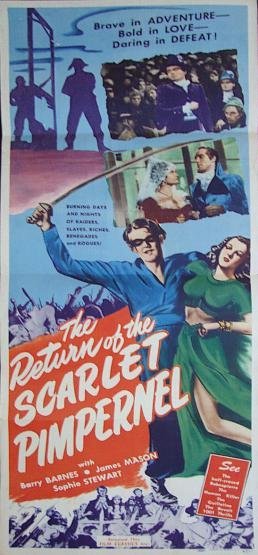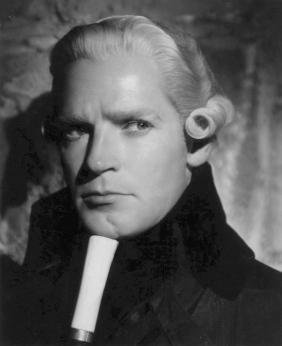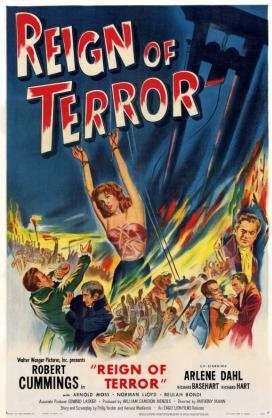Accueil > Connaître Robespierre > Le mythe « Robespierre » > Robespierre au cinéma anglophone
 Robespierre au cinéma anglophone
Robespierre au cinéma anglophone
(Robespierre in Anglophone Cinema)
mardi 28 juin 2022, par
Généralement, le cinéma et la télévision anglophones ont présenté une image fort hostile de Robespierre – une image fondée sur la propagande de l’époque de Pitt, élargie et élaborée au 19e siècle par Carlyle, Lamartine, Tussaud, et de nombreux romans et pièces de théâtre. Les films anglophones n’ont pas depeint la Révolution selon ses propres termes, mais l’ont utilisée comme substitut ou métaphore des dictatures soviétiques ou fascistes. (On le voit plus clairement dans le film de Carol Reed, Le Jeune M. Pitt (1941), une œuvre de propagande de la 2e Guerre mondiale, où la France révolutionnaire/napoléonienne remplaçe l’Allemagne nazie, avec Napoléon (Herbert Lom) sous des traits hitlériens.)
Anglophone cinema and television has generally presented a hostile image of Robespierre. It is rooted in propaganda of the Pitt era but was expanded and elaborated in the 19C by Carlyle, Lamartine, Marie Tussaud, and a number of historical novels and plays. A significant problem is that Anglophone films have not treated the Revolution on its own terms, but used it as a substitute or metaphor for Soviet or Fascist dictatorships. (This is most overt in Carol Reed’s 1941 film, The Young Mr Pitt, a work of wartime propaganda, where Revolutionary/Napoleonic France stands in for Nazi Germany, with Herbert Lom’s Hitleresque Napoléon.)
En français
La Baronne Orczy et Le Mouron Rouge

- Le Retour du Mouron Rouge (1937)
- Affiche américaine
La plupart des représentations de Robespierre à l’écran anglophones sont dans les adaptations du Mouron Rouge d’Emmuska Orczy (la pièce, 1903 ; les romans, 1905-40) : il y a sept adaptations cinématographiques (1917-1950) et plusieurs émissions télévisées. Orczy, de famille aristocratique hongroise, était anti-égalitaire et réactionnaire. Elle a dépeint Robespierre comme dictateur ou autocrate, pas simplement comme président élu de la Convention ou comme l’un des douze membres du Comité de salut public, pendant une période beaucoup plus longue que dans la réalité.
Dans Le Retour du Mouron Rouge/Le Chevalier de Londres (1937) (adapté du roman Le Triomphe du Mouron Rouge), le héros fictif Sir Percy (Barry K. Barnes) encourage Tallien (James Mason) à renverser Robespierre (Henry Oscar), pour sauver sa femme emprisonnée et aussi Thérèse Cabarrus, la maîtresse de Tallien. L’affiche dit : « Voyez le demi-fou Robespierre »
La description d’Orczy de Robespierre en The Elusive Pimpernel/Les Nouveaux Exploits du Mouron rouge (1908) – grand, décharné – ressemble beaucoup à Henry Irving, qui l’a joué dans le Robespierre de Sardou (1899). Cette pièce avait donné à Robespierre un fils adulte illégitime – à peine plausible compte tenu de son âge réel.
Cependant, quelques adaptations du Mouron Rouge le dépeignent jeune (Richard Morant dans le telefilm (1982) et Ronan Vibert dans la série BBC (1999-2000)). Orczy a utilisé aussi l’image de Robespierre en tant que dandy. Cela a été particulièrement souligné dans la série BBC 1999-2000, dans laquelle on le voit avec son tailleur, choisissant des tissus et des boutons au motif de la guillotine. Il reflète son adversaire, Sir Percy, qui est aussi à la mode. Le dernier épisode, « Un bon nom » (pas basé sur les romans d’Orczy) donne encore à Robespierre un enfant illégitime adulte, ici une fille, comme dans la pièce de Benjamin Webster, La destruction de la Bastille (1842).
Le récit de Doctor Who : The Reign of Terror (BBC 1964) est encore une variante d’Orczy, avec des espions, des déguisements et une fuite de la Conciergerie. Robespierre est appelé « le tyran de la France », et finalement, Napoléon Bonaparte - en réalité, un protégé d’Augustin Robespierre - est impliqué dans le coup thermidorien. Tous les personnages prononcent mal « Robespierre ». Il fait un contraste gênant avec La Terreur et la Vertu de la même année.
Le Livre Noir – un film noir thermidorien

- Robespierre - Richard Basehart
- Le Livre Noir (1949)
Le principal film de départ d’Orczy est le thriller politique thermidorien d’Anthony Mann, Le Livre Noir/Reign of Terror (1949). Il emploie le style du film noir/de gangsters, avec peu de références aux idéaux ou à l’idéologie de la Révolution. Robespierre, joué par Richard Basehart, est jeune et assez beau, mais il est caractérisé comme un chef de gang impitoyable « avec un esprit tordu », bien qu’on le voit avec ses pigeons, comme le décrit sa sœur Charlotte. « Ne m’appelle pas Max », dit-il. Son livre noir contient sa liste de personnes à exécuter ; les Jacobins utilisent des chambres de torture. Saint-Just (Jess Barker), comme méchant « connaisseur de roses et de sang », est montré en train de donner un coup de pied à un petit chaton adorable. Fouché (Arnold Moss) est déjà le chef de la police secrète, sa position sous Napoléon. Tallien et Barras sont appelés des « hommes honnêtes » (!).

- Le Livre Noir (1949)
- Affiche américaine
Le producteur, Walter Wanger, avait initialement proposé un film positif sur la Révolution, La Bastille, mais la politique de la guerre froide a déterminé un changement d’approche : un film sympathique à la gauche et aux soulèvements populaires n’était plus possible. Le thème de la lutte contre la tyrannie était désormais ostensiblement lancé contre la gauche, bien que le « Livre noir » ait pu être une référence voilée du Comité de la Chambre sur les activités anti-américaines de 1947 et au « blacklisting » des Hollywood 10 et des autres pour prétendues sympathies communistes.
Comédie musicale
Sur une note plus légère, Robespierre (Charles Goldner) joue un petit mais crucial rôle dans la comédie musicale romantique, The Laughing Lady/La Dame en bleu (1946). Il promet de sauver la vie du jeune aristocrate André (Webster Booth), s’il part en mission secrète en Angleterre pour rapporter un collier précieux de perles. André tombe amoureux de sa propriétaire, Denise (Anne Ziegler), et rate sa mission, mais pour le sauver, elle lui remet les perles. Robespierre – comme un roi de conte de fées – le pardonne, et tout finit bien. Le film a été réalisé au bon marché, offrant le spectacle curieux d’une copie du portrait de Reynolds de Banastre Tarleton (National Gallery, Londres) dans le bureau de Robespierre !
English
Baroness Orczy & the Scarlet Pimpernel

- Le Retour du Mouron Rouge (1937)
- Affiche américaine
The majority of Robespierre’s anglophone screen portrayals have been in adaptations of Emmuska Orczy’s Scarlet Pimpernel play (1903) and novels (1905-40) : there were seven film adaptations (1917-1950) and a number of television dramatisations. Orczy was of aristocratic Hungarian family, anti-egalitarian and reactionary in politics. She depicted Robespierre as a dictator or autocrat with sole powers, not simply as elected President of the Convention or as one of twelve members of the Committee of Public Safety, over a far longer period than in reality.
In The Return of the Scarlet Pimpernel (1937 ; adapted from The Triumph of the Scarlet Pimpernel) the fictional hero (Barry K. Barnes) encourages Tallien (James Mason) to overthrow Robespierre (Henry Oscar), to save his own imprisoned wife as well as Tallien’s mistress Teresa Cabarrus. The poster says : « See the half-crazed Robespierre ! »
Orczy’s description of Robespierre as tall and gaunt seems based on Henry Irving in Sardou’s play Robespierre. This was essentially a star-vehicle for the 61-year-old actor : the plot turns on him having an adult illegitimate son, which was barely plausible given his real age.
However, some film and television adaptations of The Scarlet Pimpernel depicted him as young (Richard Morant in the 1982 TV film, and Ronan Vibert in the 1999-2000 BBC series). Orczy employed the image of Robespierre as a dandy. This was emphasised particularly in the 1999-2000 BBC series, in which he is seen with his tailor, choosing fabrics and buttons with guillotine motifs. He mirrors his opponent, the equally fashion-conscious Sir Percy Blakeney, who also has scenes with his tailor. The final episode of the series, ‘A Good Name’ (not based on an Orczy story) gives Robespierre an adult illegitimate child, here a daughter (as in Benjamin Webster’s stage-play, The Destruction of the Bastille (1842).
Doctor Who : Reign of Terror (BBC 1964) is a science-fiction variant of Orczy, with its plot of spies, disguises and rescue from the Conciergerie. Robespierre is depicted as ‘the Tyrant of France’, and at the end of the story, it implies that Napoleon Bonaparte – in reality, a protégé of Augustin Robespierre – was involved in Thermidor. The characters mispronounce Robespierre’s name throughout. It makes an embarrassing contrast with La Terreur et la Vertu of the same year.
The Black Book : Thermidor as Film Noir

- Robespierre - Richard Basehart
- Le Livre Noir (1949)
The main film departure from Orczy is Anthony Mann’s Thermidorian political thriller The Black Book : Reign of Terror (1949). It employs the style of the film noir/gangster film, with scant reference to the ideals and ideology of the Revolution. Robespierre is played by Richard Basehart, a young and handsome actor, but he is characterised as a ruthless gang-leader “with a twisted mind”, although the film includes his love of pigeons, as described by Charlotte. “Don’t call me Max,” he says.
The ’Black Book’ contains Robespierre’s list of people to be executed so that he can become dictator. The Jacobins are depicted as using torture chambers. To confirm his status as a villainous “connoisseur of roses and blood”, Saint-Just (Jess Barker) is shown kicking a kitten. Fouché (Arnold Moss) is depicted as Chief of Secret Police, a role closer to his position under Napoléon. Tallien and Barras are described as “honest men” (!).

- Le Livre Noir (1949)
- Affiche américaine
The producer, Walter Wanger, had originally proposed a positive film about the Revolution, The Bastille, but Cold War politics determined a change of approach : a film sympathetic to the Left and to popular uprisings was no longer possible. The theme of struggle against tyranny was now ostensibly pitched against the Left, although the ‘Black Book’ may have been a veiled reference to the 1947 House Committee on Un-American Activities hearings and the ‘blacklisting’ of the Hollywood Ten and many others for alleged Communist sympathies.
A Musical Comedy
On a lighter note, Robespierre (Charles Goldner) has a small but crucial role in a romantic musical, The Laughing Lady (1946). He promises to spare a young aristocrat, André (Webster Booth), if he goes on a secret mission to England to bring back some valuable pearls. The young man falls in love with its owner, Denise (Anne Ziegler), and fails his mission, but to save him, she hands over the pearls. Robespierre – like a fairy-tale monarch – spares him, and all ends happily. The film was made on a very low post-war budget, offering the curious sight of Robespierre’s office containing a copy of Reynolds’ portrait of Banastre Tarleton !
Filmographie :
- Le Retour du Mouron Rouge/Le Chevalier de Londres (1937)
- Le Mouron Rouge (1982)
- Doctor Who : The Reign of Terror (1964)
- Le Livre Noir/Reign of Terror)(1949)
- The Laughing Lady/La Dame en bleu (1946)
À lire plus :
- Sylvie Dallet, La Révolution Française et le cinéma (Paris : Éditions des Quatre-Vents, 1988)
- Sylvie Dallet & Francis Gendron, Filmographie Mondiale de la Révolution Française (Paris : Éditions des Quatre-Vents, 1989)
- Nathaniel Deyo, Film Noir and the Possibilities of Hollywood (Basingstoke : Palgrave Macmillan, 2020)
- Sally Dugan, Baroness Orczy’s The Scarlet Pimpernel : A Publishing History (London : Routledge, 2012)
- Leger Grindon, Shadows on the Past : Studies in the Historical Fiction Film (Philadelphia : Temple University Press, 1994)
- Colin Jones, Josephine McDonagh, & Jon Mee, Charles Dickens, A Tale of Two Cities and the French Revolution (Basingstoke : Palgrave Macmillan, 2009)
- Geoff Tibballs, The Making of the Scarlet Pimpernel : The Official Companion to the BBC Series (London and Basingstoke : Macmillan Boxtree, 1998).



